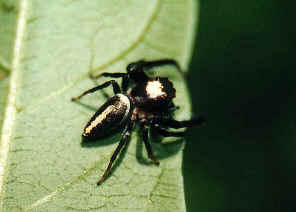|
|
FAMILY SALTICIDAE - Jumping Spiders
This page contains pictures and information about Jumping Spiders that we found in the Brisbane area, Queensland, Australia.

- Body length 10mm
- Jumping spiders are called Pussy Cat in Chinese. The above picture shows a Jumping Spider with a cat's face, this may explain why they are called.
Jumping Spider is a very large family contains the most colourful species of spiders. They are small to medium size. They are easily recognized by their eyes pattern. Their front pair of eyes are very large, with three pair of smaller eyes on thorax. They have very good eyesight and very active. Each species in this family have different colourful patterns on their body. When you look at them, they will either hide away on the other side of the leaf or will turn their head and look back at you.
- Jumping spiders do not build webs. They make silken retreats between leaves, barks or stones. Their retreats usually have opening at both ends. They hide in their retreats at night and during winter.
- The females lay their eggs in their retreats in spring and summer. Their number of eggs is relatively fewer than most other spiders. Female spiders will guard their eggs. Usually Jumping Spiders will not hunt too far away from their retreats.
- When they move or jump, they always leave a safety line of silk, or the drag-line, behind. Look carefully at the about pictures you will see the drag-line attached from the spider abdomen tip to a leaf. If the jump fails the spiders can crawl back to its original position and this prevents them from falling down.
Jumping Spiders hunt on plants during the day. They use their excellent vision to track the prey and estimate distance. Then suddenly jump on their prey. They use their third and fourth pair of legs for jumping. They seize prey by front pair of legs.
Jumping Spiders are the predator of small spiders and insects. However, we found that Jumping spiders are the prey of the Mud-Dauber Wasps.
Followings are the different species of Jumping Spiders that we found.
- Green Jumping Spider, Northern Green Jumping Spider


- Mopsus mormon, male body length 15mm, female body length 10mm
- Green Jumping Spider is the largest jumping spider in Australia. This is a beautiful large Jumping Spider. Its body is bright green in colour with dark red head. The front pair of big eyes cover half of its dark face, below are the very large fangs. On the abdomen there is the white colour on green with two black lines. Its legs are green to dark red in colour. The male and female look slightly different. The male has the hairy white clown around its head. Female is smaller and with patterned thorax. More pictures and information in this page.
- Wattle Jumping Spider


- Sandalodes albobarbatus, body length 8mm
- We found this Jumping Spider on wattle leaf and stem a few times. It has the very long and strong front legs. Its front pair eyes are large and with eyebrow. The white markings on this black spider are distinctive. The patterns are variable in different individuals. This spider is common in eucalypt forests in Brisbane. More details please click on here.
- Biting Jumping Spider


- Opisthoncus mordax, body length 10mm
- We found this jumping spider hunting on leave during day time. It body is shiny black in colour, with a with line on the middle of its abdomen. The first pair of legs are strong and with spines. This Jumping Spider is common in Brisbane gardens and backyards. Click here for more pictures and information.
- Thin Jumping Spider


- Opisthoncus necator, body length 10mm
- Garden Jumping Spider
-


- Opisthoncus sp., body length 10mm
- The spider is brown in colour with white pattern on its abdomen and thorax. The spider hunt actively during day time. The spider is usually found hunting on green leaves. Garden Jumping Spider is common in garden and backyard in Brisbane. Click here for more pictures and information.
- Small Garden Jumping Spider


- Opisthoncus sp., body length 6mm
- Ludicra Jumping Spider


- Bavia ludicra, female, body length 12mm
- This is quite a large jumping spider. We sometimes found them hunting on young Eucalyptus tree. Click here for more pictures and information.
- Chink Jumping Spider


- Holoplatys sp., body length 10mm
- This is a large Jumping Spider. It hunts on gum tree trunk by jumping down to prey land on the tree trunk. The spider has a flattened brown abdomen that is an elongate oval shape. More information and pictures please click on here.
- Salticid Ant Eater


- Zenodorus orbiculatus, body length 6mm
- We can easily find this small Jumping Spiders on gum and wattle tree trunks. The spider shiny black or dark brown, with a white line circle the edge of its abdomen. Some with a white dot at the centre. We saw the spiders feeding on different species of ants many times. More information and pictures please visit this page.
- Jumping Spider


- Helpis sp., body length 10mm
- This is another species of Jumping Spider, with slender body light brown in colour. In the above picture, one leg of the spider is missing.

- There are the Ant-mimic Jumping Spiders in this page.
- There are Un-identified Jumping Spiders in this page.


